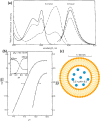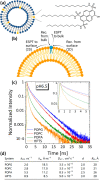The Dual Use of the Pyranine (HPTS) Fluorescent Probe: A Ground-State pH Indicator and an Excited-State Proton Transfer Probe
- PMID: 36053265
- PMCID: PMC9494743
- DOI: 10.1021/acs.accounts.2c00458
The Dual Use of the Pyranine (HPTS) Fluorescent Probe: A Ground-State pH Indicator and an Excited-State Proton Transfer Probe
Abstract
Molecular fluorescent probes are an essential experimental tool in many fields, ranging from biology to chemistry and materials science, to study the localization and other environmental properties surrounding the fluorescent probe. Thousands of different molecular fluorescent probes can be grouped into different families according to their photophysical properties. This Account focuses on a unique class of fluorescent probes that distinguishes itself from all other probes. This class is termed photoacids, which are molecules exhibiting a change in their acid-base transition between the ground and excited states, resulting in a large change in their pKa values between these two states, which is thermodynamically described using the Förster cycle. While there are many different photoacids, we focus only on pyranine, which is the most used photoacid, with pKa values of ∼7.4 and ∼0.4 for its ground and excited states, respectively. Such a difference between the pKa values is the basis for the dual use of the pyranine fluorescent probe. Furthermore, the protonated and deprotonated states of pyranine absorb and emit at different wavelengths, making it easy to focus on a specific state. Pyranine has been used for decades as a fluorescent pH indicator for physiological pH values, which is based on its acid-base equilibrium in the ground state. While the unique excited-state proton transfer (ESPT) properties of photoacids have been explored for more than a half-century, it is only recently that photoacids and especially pyranine have been used as fluorescent probes for the local environment of the probe, especially the hydration layer surrounding it and related proton diffusion properties. Such use of photoacids is based on their capability for ESPT from the photoacid to a nearby proton acceptor, which is usually, but not necessarily, water. In this Account, we detail the photophysical properties of pyranine, distinguishing between the processes in the ground state and the ones in the excited state. We further review the different utilization of pyranine for probing different properties of the environment. Our main perspective is on the emerging use of the ESPT process for deciphering the hydration layer around the probe and other parameters related to proton diffusion taking place while the molecule is in the excited state, focusing primarily on bio-related materials. Special attention is given to how to perform the experiments and, most importantly, how to interpret their results. We also briefly discuss the breadth of possibilities in making pyranine derivatives and the use of pyranine for controlling dynamic reactions.
Conflict of interest statement
The authors declare no competing financial interest.
Figures










Similar articles
-
A dual experimental-theoretical perspective on ESPT photoacids and their challenges ahead.Chem Sci. 2024 Dec 2;16(4):1560-1596. doi: 10.1039/d4sc07148d. eCollection 2025 Jan 22. Chem Sci. 2024. PMID: 39759939 Free PMC article. Review.
-
Modulation and Salt-Induced Reverse Modulation of the Excited-State Proton-Transfer Process of Lysozymized Pyranine: The Contrasting Scenario of the Ground-State Acid-Base Equilibrium of the Photoacid.J Phys Chem B. 2016 Jul 28;120(29):7076-87. doi: 10.1021/acs.jpcb.6b04111. Epub 2016 Jul 20. J Phys Chem B. 2016. PMID: 27355857
-
Structural Origin and Vibrational Fingerprints of the Ultrafast Excited State Proton Transfer of the Pyranine-Acetate Complex in Aqueous Solution.J Phys Chem B. 2021 Sep 16;125(36):10273-10281. doi: 10.1021/acs.jpcb.1c05590. Epub 2021 Sep 2. J Phys Chem B. 2021. PMID: 34472354
-
Solvent dependence of excited-state proton transfer from pyranine-derived photoacids.Phys Chem Chem Phys. 2014 May 21;16(19):9104-14. doi: 10.1039/c3cp55292f. Phys Chem Chem Phys. 2014. PMID: 24700348
-
Excited state proton transfer based fluorescent molecular probes and their application in studying lipid bilayer membranes.Photochem Photobiol Sci. 2019 Dec 1;18(12):2830-2848. doi: 10.1039/c9pp00294d. Epub 2019 Nov 25. Photochem Photobiol Sci. 2019. PMID: 31763658 Review.
Cited by
-
A dual experimental-theoretical perspective on ESPT photoacids and their challenges ahead.Chem Sci. 2024 Dec 2;16(4):1560-1596. doi: 10.1039/d4sc07148d. eCollection 2025 Jan 22. Chem Sci. 2024. PMID: 39759939 Free PMC article. Review.
-
Curvature-Assisted Vesicle Explosion Under Light-Induced Asymmetric Oxidation.Adv Sci (Weinh). 2024 Oct;11(38):e2400504. doi: 10.1002/advs.202400504. Epub 2024 Aug 13. Adv Sci (Weinh). 2024. PMID: 39136143 Free PMC article.
-
A Ratiometric Fluorescence Nano pH Biosensor for Live-Cell Imaging Using Cerasome.Biosensors (Basel). 2025 Feb 16;15(2):114. doi: 10.3390/bios15020114. Biosensors (Basel). 2025. PMID: 39997016 Free PMC article.
-
Scalable integration of photoresponsive highly aligned nanochannels for self-powered ionic devices.Sci Adv. 2024 Dec 20;10(51):eads5591. doi: 10.1126/sciadv.ads5591. Epub 2024 Dec 20. Sci Adv. 2024. PMID: 39705341 Free PMC article.
-
Nucleotide-mediated modulation of chemoselective protein functionalization in a liquid-like condensed phase.Commun Chem. 2024 Oct 26;7(1):242. doi: 10.1038/s42004-024-01333-w. Commun Chem. 2024. PMID: 39462061 Free PMC article.
References
Publication types
MeSH terms
Substances
LinkOut - more resources
Full Text Sources

